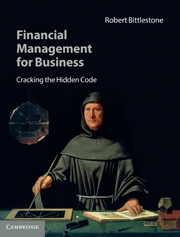Book contents
- Frontmatter
- Contents
- List of figures
- Introduction
- Acknowledgements
- Part 1 A dream of future wealth
- 1 Income and outcome
- 2 Fool's gold
- 3 Play the game
- 4 The judgment of balance
- 5 Return to reality
- 6 The cost of success
- 7 Profit and cash
- 8 Time to take stock
- 9 A capital asset
- 10 Mind your own business
- 11 The taxonomy of fog
- 12 The Merchant of Florence
- Part 2 The hidden art of management
- Appendix 1 Mathematical anchor
- Appendix 2 Getting to grips with cash
- Postscript
- Bibliography
- Index
5 - Return to reality
from Part 1 - A dream of future wealth
Published online by Cambridge University Press: 05 June 2014
- Frontmatter
- Contents
- List of figures
- Introduction
- Acknowledgements
- Part 1 A dream of future wealth
- 1 Income and outcome
- 2 Fool's gold
- 3 Play the game
- 4 The judgment of balance
- 5 Return to reality
- 6 The cost of success
- 7 Profit and cash
- 8 Time to take stock
- 9 A capital asset
- 10 Mind your own business
- 11 The taxonomy of fog
- 12 The Merchant of Florence
- Part 2 The hidden art of management
- Appendix 1 Mathematical anchor
- Appendix 2 Getting to grips with cash
- Postscript
- Bibliography
- Index
Summary
Following the stock market crash of 1929, the Securities and Exchange Commission (SEC) required all publicly traded companies to publish annual financial statements, audited by independent accounting firms, based on a set of accounting standards that the profession had initially established itself.
Robert Eccles et al.Most people seem to enjoy using these simulation models for a while, but I have noticed that sooner or later a certain restlessness creeps in. Those moving pipes and changing levels of water start to appear divorced from financial reality and so we now need to relate them to normal business terms. It is time to load Model 103 (Figure 5.1).
This business is the same fruit-selling operation as the one in Figure 4.2, but I have now added a table of numbers on the right-hand side which displays the financial accounts for this business. In the case of the Sales and Receipts pipes, the first column presents us with the amount that has flowed along the pipe each day, the second column shows us the cumulative total of the flow since the beginning of the year and the third column identifies the cumulative total of the flow over all the years since the business was started.
That is true for the Sales and Receipts pipes, but matters are different for the values of the boxes that are listed in the Balance Sheet and in the sections below it. In the Balance Sheet itself, the boxes are all ‘Closing’ period values.
- Type
- Chapter
- Information
- Financial Management for BusinessCracking the Hidden Code, pp. 32 - 36Publisher: Cambridge University PressPrint publication year: 2010



